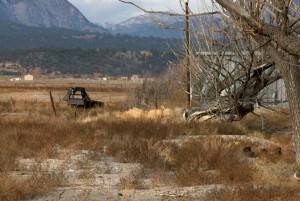By Tina Mitchell
Every weekend from mid-March through early August, you’ll find me checking more than 100 nestboxes on our 39 acres in western Fremont County. Remember that scorching, enervating, record-breaking heat of last summer? Yep, I was out there, on foot, each Friday and Saturday afternoon, sweating, plodding – and having a grand time. Why? Monitoring nestboxes affords me glimpses of bird families in the thick of raising their young. If all goes according to plan, for a few weeks each summer two parents spend every minute of daylight protecting their young and delivering protein-rich insect meals to their offspring multiple times an hour. And I get to watch.
The eight species of birds nesting in our boxes exhibit the most common avian “family” structure: a male and female parent working together to build a nest; to defend a territory and its food supplies; to hatch, feed and protect their naked and helpless young (referred to as “altricial”); and to teach the youngsters, once they leave the nest, how to find food on their own. More than 80% of all bird species raise their young this way – American Robins, Mountain Bluebirds, House Finches and just about any bird you might see around your house in spring or summer.
Other family arrangements occur in the avian world, though. Some species feature a single-mother family and a “deadbeat dad.” Hummingbirds – in our area, Broad-tailed and Black-chinned Hummingbirds – raise young in these types of families. A male hummingbird parks himself on an exposed branch, waiting for a female to zip by. The male breaks into a frenzied, swooping flight display, hoping to attract her attention. Once she consents to his overtures, he serves only as a sperm donor and then loses all interest in the family. The female builds her tiny nest, lays two jelly-bean-sized eggs, and raises the two youngsters completely on her own. Meanwhile, the male spends the summer defending various flowers and feeders all for himself. Offspring? What offspring?
If you think that family structure sounds deadbeat, let’s talk about cowbirds. Known as brood parasites, the male defends no territory and the female builds no nest. Instead, she lays her eggs – perhaps 30 to 50 each breeding season! – in other birds’ nests. In our area, common cowbird hosts include Yellow Warblers, Song Sparrows and Chipping Sparrows, among many others. Typically, the cowbird baby hatches two to four days earlier, develops faster, and easily out-competes the other hatchlings for food. As a result, some or all of the parents’ genetic offspring starve. A few species – for instance, American Robins and Bullock’s Orioles – recognize a cowbird egg before it hatches. They either toss it out or build a new nest over the entire clutch of eggs and start again. But usually the conscripted foster parents run themselves ragged trying to find sufficient food for the huge, demanding young stranger. In the meantime, the cowbird parents have moved on, footloose and fancy-free.
Who hasn’t seen a video of a seemingly oblivious female Mallard, trailed by scrambling tiny ducklings, trying to cross a busy street? (Shades of the children’s classic “Make Way for Ducklings.”) What kind of family is that? Unlike the altricial youngsters of most birds, shorebirds and waterfowl babies emerge from eggs ready to head out into the world within 24 hours of hatching (called “precocial”). Sometimes, as with Canada Geese, both parents guard their family of precocial fluffballs as they lead the kids to good feeding spots. In other species, such as the Mallard in the video, the father fades from the scene by the time the eggs hatch. The mother just provides a large object for the newly hatched ducklings to follow to feeding grounds and water. And in a few species – most notably in our area, Spotted Sandpipers – the female gets the “deadbeat” honors, playing little part in the family after laying eggs and leaving the bulk of incubation, brooding and guarding of the young to Dad. Instead, off she heads to find another male, leaving her first mate to manage all of the family chores.
Although none breed in our area, more than 250 species worldwide actually live in multigenerational family groups made up of parents, adult children, stepparents, siblings and half-siblings. Such extended families tend to be found in areas with very limited decent breeding territories – perhaps explaining why adult birds would choose to forgo their own breeding chances to help raise the young of other birds.
Most avian families disband at the end of the breeding season, once the young have grown and can live independently – the original empty nest syndrome, without the tinge of human sadness. But come next spring, you too might catch glimpses into the family life of birds. Watch for birds flying with food in their beaks – one of the best clues that an industrious parent is heading back to its family to feed noisy, begging, impatient members of the next generation.
Tina Mitchell watches nature with her human and canine family from their perch in the piñon/juniper habitat of western Fremont County. When she needs to pay the bills, she shows up as a research psychologist on the University of Colorado Anschutz Medical Campus in Aurora.

